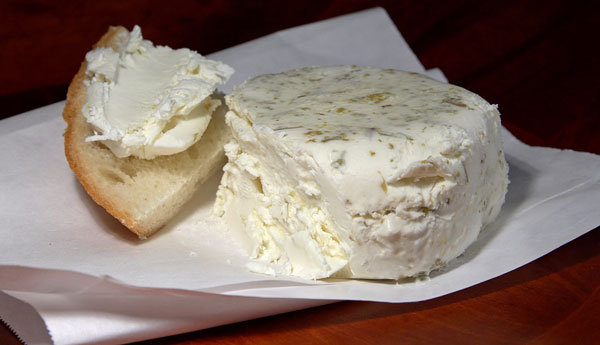
As I write this, it’s just around mealtime, which may have slightly influenced my choice of topic. If you’ve come here from Part One of our goat series, chances are you already know what you’re in for, but if not, welcome to basic cheese-making 101! Today we’ll be tackling the simplest cheese I’m aware of, which as it happens, can be made from the milk of your very own goats. This, of course, is Chevre, or if you’re using cow’s milk, Fromage Blanc–and as it happens, it’s one of the most delectable cheeses I know.
Supplies
This may sound hard to believe, but literally all you will need ingredients-wise to make a pound of Chevre is a gallon of goat’s milk, a packet of Chevre culture, non-iodized salt and, if your milk is pasteurized, calcium chloride. Add this last item in the night before, so it has plenty of time to work. For tools, a 6-quart pot, a cheesecloth or a butter muslin, and a colander are all that is necessary, alongside the usual utensils such as a knife and spoon.
The Process
First warm your milk to anywhere from 72-86 degrees Fahrenheit. If it is winter, the warmer temperature often works better, while in the heat of the summer, 72 degrees is plenty. As this is far too low a temperature to achieve on a stove, put the milk in your pot, and put the pot in a sink full of warm water to heat it. Once the milk hits the proper temperature, add your chevre culture. Let it float on top for a minute and really soak in the moisture before stirring it in. This will prevent clumping.
This next part is my favorite. Go tend the goats, take a hike, or go to bed, cause guess what? The milk now needs some alone time. Six to 12 hours of it, in fact. Some of my fellow distillers will doubtless worry whether the cultures stop working if the milk gets too cold. While I cannot claim to be as expert on the cultures that go into a cheese as I am on those that go into a fine mash, I do know that the milk’s sheer mass will keep it fairly warm, so this is not something to really worry about. Just don’t leave your pot directly next to an AC vent, or somewhere in the Arctic Circle.
The period above allows the milk to properly coagulate, so when a decent curd has formed, you’ll see a thin layer of whey over the curd mass, which may crack a bit. If poked, it will break clean. This curd can now be transferred to your cheesecloth, or other straining device. Drape the cheesecloth or muslin over your colander, ladle in the curd and … you guessed it …. wait. To be precise, about six to 36 hours this time, with a room temperature around 70 degrees. Why the large disparity? The longer you wait, the drier and more acidic (read: tangy) the cheese becomes, while a shorter time will yield a sweeter and more moist cheese. As far as temperature goes, if your drain-room temperature is much higher than 72 degrees, the cheese will dry out quicker. Lower than 68, and it will never really lose enough moisture to keep very long.
Draining finished, it’s time to salt the cheese (remember, non-iodized)–about 2 tablespoons per pound should do. This will help slow the bacteria from acidifying your cheese any further, as will immediately placing it in your fridge. Before you put it away to chill, however, remember to add any herbs and spices you’d like to flavor the cheese with. I myself am partial to either rosemary or parsley, and just a dash of lemon zest. Once stored, your cheese should keep for about two weeks, though it never lasts that long in my house. Enjoy!
A humble homesteader based in an undisclosed location, Lars Drecker splits his time between tending his little slice of self-sustaining heaven, and bothering his neighbors to do his work for him. This is mainly the fault of a debilitating predilection for fishing, hunting, camping and all other things outdoors. When not engaged in any of the above activities, you can normally find him broken down on the side of the road, in some piece of junk he just “fixed-up.”

Nobody says
Your links are broken. Clicked on raised garden and get goat cheese. Don’t you people ever proof your articles? SHEESH.
Michael Highland says
I would like to know once everything above has been completed can this cheese be cold smoked.